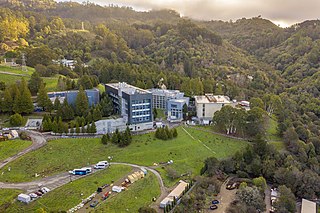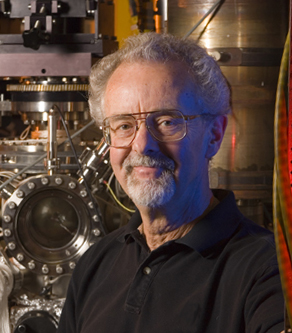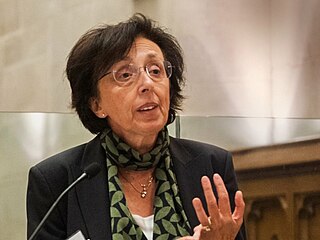Related Research Articles

Lawrence Berkeley National Laboratory (LBNL) is a federally funded research and development center in the hills of Berkeley, California, United States. Established in 1931 by the University of California (UC), the laboratory is sponsored by the United States Department of Energy and administered by the UC system. Ernest Lawrence, who won the Nobel prize for inventing the cyclotron, founded the lab and served as its director until his death in 1958. Located in the Berkeley Hills, the lab overlooks the campus of the University of California, Berkeley.

Earl Ward Plummer was an American physicist. His main contributions were in surface physics of metals. Plummer was a professor of physics at Louisiana State University, University of Pennsylvania and the University of Tennessee - Knoxville.

Cherry A. Murray is an American academic who is professor of physics and the director of the Biosphere2 Institute at the University of Arizona at Tucson. She is the Benjamin Peirce Professor of Technology and Public Policy emerita at, and former dean of, the Harvard School of Engineering and Applied Sciences (SEAS).

Peidong Yang is a Chinese–American chemist, material scientist, and businessman. He is currently a professor at the University of California, Berkeley and a member of the American Academy of Arts and Sciences. He is a Professor of Chemistry and a Professor of Materials Science. His research group studies the synthesis of nanomaterials and their electronic and optical properties. He is also a Department Head at the Joint Center for Artificial Photosynthesis, Senior Faculty Scientist at Lawrence Berkeley National Laboratory, and Deputy Director of the Center of Integrated Nanomechanical Systems (COINS). He is an associate editor of the Journal of the American Chemical Society, an American Chemical Society Journal.
Kennedy J. Reed was an American theoretical atomic physicist in the Theory Group in the Physics & Advanced Technologies Directorate at Lawrence Livermore National Laboratory (LLNL) and a founder of the National Physical Science Consortium (NPSC), a group of about 30 universities that provides physics fellowships for women and minorities.

Giulia Galli is a condensed-matter physicist. She is the Liew Family Professor of Electronic Structure and Simulations in the Pritzker School of Molecular Engineering and the department of chemistry at the University of Chicago and senior scientist at Argonne National Laboratory. She is also the director of the Midwest Integrated Center for Computational Materials. She is recognized for her contributions to the fields of computational condensed-matter, materials science, and nanoscience, most notably first principles simulations of materials and liquids, in particular materials for energy, properties of water, and excited state phenomena.

Christine Angela Aidala is an American high-energy nuclear physicist, Alfred P. Sloan Research Fellow and Associate Professor of Physics at the University of Michigan. She studies nucleon structure and parton dynamics in quantum chromodynamics.

Dawn Angela Shaughnessy is an American radiochemist and principal investigator of the heavy element group at the Lawrence Livermore National Laboratory. She was involved in the discovery of five superheavy elements with atomic numbers 114 to 118.
Félicie Albert is a French and American physicist working on laser plasma accelerators. She is the deputy director for the Center for High Energy Density Science at Lawrence Livermore National Laboratory (LLNL) and staff scientist at the National Ignition Facility and Photon Science Directorate and the Joint High Energy Density Sciences organization.
Junqiao Wu is a Chancellor's professor and Department Chair of materials science at the University of California, Berkeley. Wu's materials science research focuses on semiconductors, electronic materials and thermal energy transport. Wu's research in semiconductors has led to major discoveries in the field, such as indium gallium nitride alloys have bandgaps spanning the entire near infrared to ultraviolet spectrum, electrons in vanadium dioxide conduct energy without conducting heat, a temperature adaptive radiative coating that automatically switches thermal emissivity, as well as a range of applications in solar cells, infrared imaging, photonics, and thermoelectrics. He received a BS degree from Fudan University, a MS degree from Peking University, and a PhD degree under Prof. Eugene Haller from UC Berkeley. He received postdoctoral training under Prof. Hongkun Park from Harvard University. His honors include the Berkeley Fellowship, the 29th Ross N. Tucker Memorial Award, the U.C. Regents' Junior Faculty Fellowship, the Berkeley Presidential Chair Fellowship, the US-NSF Career Award, the US-DOE Early Career Award, the Presidential Early Career Award for Scientists and Engineers (PECASE) from the White House, the Outstanding Alumni Award from Peking University China, the Bakar Faculty Fellows Award, elected Fellow from the American Physical Society (APS) and the 2023 John Bardeen Award from the Minerals, Metals and Materials Society (TMS). He is currently on the Chair Line of the Division of Materials Physics at the American Physical Society (APS), and holds joint appointment at the Lawrence Berkeley National Laboratory.
Mark Beno was a Senior Chemist at the Argonne National Laboratory best known for his work in chemical crystallography. He was the first to determine the crystal structure of the high temperature superconductor, YBa2Cu3O7, and his research continues to help researchers understand the types and structures that are likely to form this class. Beno was posthumously awarded the distinction of Fellow by the American Association for the Advancement of Science (AAAS).
Natalie Ann Roe is an experimental particle physicist and observational cosmologist, and the Associate Laboratory Director for the Physical Sciences Area at Lawrence Berkeley National Laboratory (LBNL) since 2020. Previously, she was the Physics Division Director for eight years. She has been awarded as the Fellow of American Physical Society (APS) and American Association for the Advancement of Science (AAAS) for her exceptional scientific career and contributions.
Vivien Zapf is an American research scientist at the National High Magnetic Field Laboratory pulsed field facility at Los Alamos National Laboratory.

Kimberly Susan Budil is an American physicist who is the 13th and current director of Lawrence Livermore National Laboratory, making her the first woman to hold this position. She completed her bachelor's degree in physics from the University of Illinois Chicago, and her master's and doctorate in applied science from the University of California, Davis. She collaborated with Nobel laureate Donna Strickland, and made significant contributions to the field of high-power, ultra-fast lasers. Starting her career at Lawrence Livermore National Laboratory in 1987, she held various roles across government departments, including the Department of Energy and the Department of Defense. In 2014, she managed relations between the University of California's campuses and the three Department of Energy labs it manages. Budil, who was made a fellow of the American Physical Society in 2019, has also been a prominent advocate for women in science.
Dana Dattelbaum is an American physicist and scientist at Los Alamos National Laboratory. She leads NNSA’s Dynamic Materials Properties portfolio at LANL, which provides experimental data, platforms and diagnostics for materials behaviors relevant to nuclear weapons performance, ranging from plutonium to high explosives.
Nancy Haegel is an American electrical engineer, materials scientist, and solar power researcher, known for her work on semiconductors and large-scale photovoltaic energy systems. Other topics in her research include imaging electronic processes and detecting nuclear radiation. Formerly a distinguished professor of physics at the Naval Postgraduate School, she is the director of the Materials Science Center in the National Renewable Energy Laboratory, and a director of the Research Corporation.
Christine Anne Coverdale is an American plasma physicist at Sandia National Laboratories, where she is a Distinguished Member of the Technical Staff.
Beverley Ann P. Taylor is an American physicist and physics educator known for her physics books for children. She is a professor emerita at Miami University Hamilton in Hamilton, Ohio.

Tammy Ma is an American plasma physicist who works on inertial confinement fusion at the Lawrence Livermore National Laboratory.

Andrea Lynn "Annie" Kritcher is an American nuclear engineer and physicist who works at the Lawrence Livermore National Laboratory. She was responsible for the development of Hybrid-E, a capsule that enables inertial confinement fusion. She was elected Fellow of the American Physical Society in 2022.
References
- 1 2 "Christine A. Orme", BioNanomaterials Group Members, Lawrence Livermore National Laboratory, retrieved 2022-07-05
- 1 2 Interview with Alumna Christine Orme (Ph.D. '95) (PDF), University of Michigan, retrieved 2022-07-05
- ↑ DOE's Winners Since 1996, Department of Energy, 13 August 2019, retrieved 2024-04-15
- ↑ "Fellows nominated in 2009 by the Division of Materials Physics", APS Fellows archive, American Physical Society, retrieved 2022-07-05
- ↑ DOE recognizes Lab's outstanding mentors, Lawrence Livermore National Laboratory, 2 July 2010, retrieved 2022-07-05